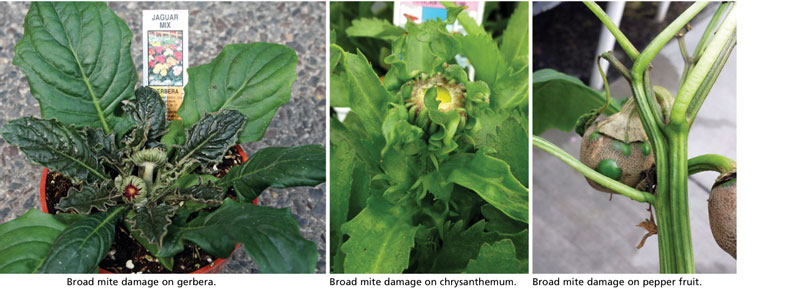3/1/2019
Broad Mites: A Game of Hide & Seek
Virginia Brubaker
Broad mites (Polyphagotarsonemus latus) are a formidable, yet elusive, foe. They’re microscopic and notoriously difficult to locate, even with magnification of 20 times or higher. Female broad mites are only 0.2-mm long; the males are even smaller.
The detection dilemma is intensified by the fact that the mites are reclusive, often tucked away deep in the folded growing-tip tissue. Female broad mites may pupate and wait in the soil until they find the appropriate host on which to feed.
Broad mites also have distinctive eggs, which aid in their diagnosis. Their eggs are translucent and oval-shaped with a geometric cross-hatched pattern of white dots on the surface, creating this unique and identifying feature. The eggs are usually found on the undersides of leaves, but are sometimes also found on the upper leaf surface.
Because of their tiny size, plant damage by broad mites is often well underway before the source is discovered. One symptom that could indicate a broad-mite infestation is curled leaves and gnarled, hard-looking foliage. Another is stunting of tender growing tissue. In severe cases, broad mites have been found feeding on flowers, causing distortion and on the fruit of certain crops, causing deformed, cork-like scabs.
The nearly colorless broad mite injects a toxin as they feed, which contributes to the color change, cupping and even death of plant tissue. Since high soluble salts or environmental factors can cause similar symptoms, a positive identification is essential in making the correct treatment.
In contrast to their size, broad mites have an appetite for a large variety of plants. Host crops include ageratum, azalea, begonia, dahlia, gerbera daisy, ivy, bedding impatiens, lantana, marigold, New Guinea impatiens, peppers, snapdragon, torenia, verbena and zinnia.
Translaminar systemic miticides are the preferred methods of broad mite control. The miticides, which have translaminar activity, penetrate the leaf and move within the tissue from top to bottom. Foliar spray options include Avid, Kontos, Pylon, Savate and Sirocco. Akari and Sanmite aren’t translaminar systemics, but have good contact spray activity, which can be beneficial in any spray rotation plan.
Growers who currently apply Kontos as an early soil drench benefit from preventative control of both spider mites and broad mites through true systemic activity. Systemic insecticides are those in which the active ingredient is taken up, primarily by plant roots, and transported to different locations throughout the plant.
A systemic drench has several advantages over foliar sprays. The benefits include control of a greater number of pests, as well as an increase in the amount of control residual. A Kontos drench can provide several weeks of control from a single application, whereas foliar sprays provide less activity.
Last, but not least, many products have a reduced re-entry interval (REI) when applied as a drench, so long as label conditions are met. It’s advised that you always read pesticide labels and make sure to follow all label recommendations and restrictions. Products other than those mentioned here may also be safe and effective. GT

Virginia Brubaker is GGSPro Technical Support Supervisor for Griffin. She can be reached at ggsprotech@griffinmail.com.